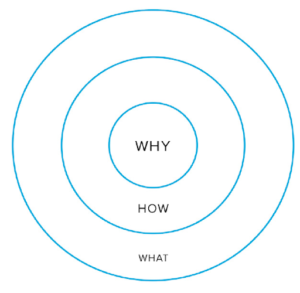
25 Feb BRAND IDENTITY DESIGN: A BEGINNERS’ GUIDE PART I
Brand identity shapes the success of a business. It is how customers perceive your brand. The different aspects of a brand identity such as design, content, and value, drive the target audience towards the ultimate business goal. But where to start from?
Out of the five senses of humans, sight is the one where you can start attracting customers. People first see and then react to what they see. Hence, the brand identity design becomes your starting point.
Discover the purpose behind the brand.
It’s wrong to assume that logos have to be just creative. The purpose of a brand should become your passion rather than logo design. The message a brand wishes to convey to its target audience helps you identify the brand value.
To discover that value, use The Golden Circle methodology in the form of question answers.

Competitive research
While planning a brand identity, your first goal should be differentiation from the industry competitions. It can convince a customer to purchase your product/service over competitions’.
Create a visual table to understand the similarities and differences of the competition. You can use a spreadsheet (Google Sheets, Excel), a notepad, or the template on the next page.
A few questions to ask yourself before you lift the drawing pen:
- Is the competitor consistent in their message and visual identity across channels?
- What kind of quality do competitors provide in their products or services?
- Does the competitor have customer reviews or social mentions about them?
- In what ways does the competitor market their business, both online and offline?
Aside from this logo or brand identity design-related research, you can also deep dive into other areas of competitive research such as social media engagement and content publishing. It helps you understand the market even more.
Define your brand’s target audience.

Depending on the product/service and company values, the client will give you their target group. But studying and creating a set of a niche audience is an advertiser’s work. When deciding your TG, focus on who exactly you are trying to reach. You’ll need to curate your mission and message to meet that TG’s exact needs.
The key is to get specific, by figuring out the detailed behaviors and lifestyle of your consumers. This can help you tailor the brand message that easily communicates itself to the TG.
Define your brand mission statement.
Before you can build a brand identity design that your audience trusts, you need to know what value your business provides. Craft a clear and concise expression of what your company/client/brand is most passionate about. The mission statement should define a purpose for existing. Use your what, how, and why to put together the purpose into a concise statement.
This was the pre-practice to build brand identity design or a logo design for a brand. In the next article, we will talk about starting the process of brand building. Until then, subscribe to our newsletter to see our latest work.



Sorry, the comment form is closed at this time.